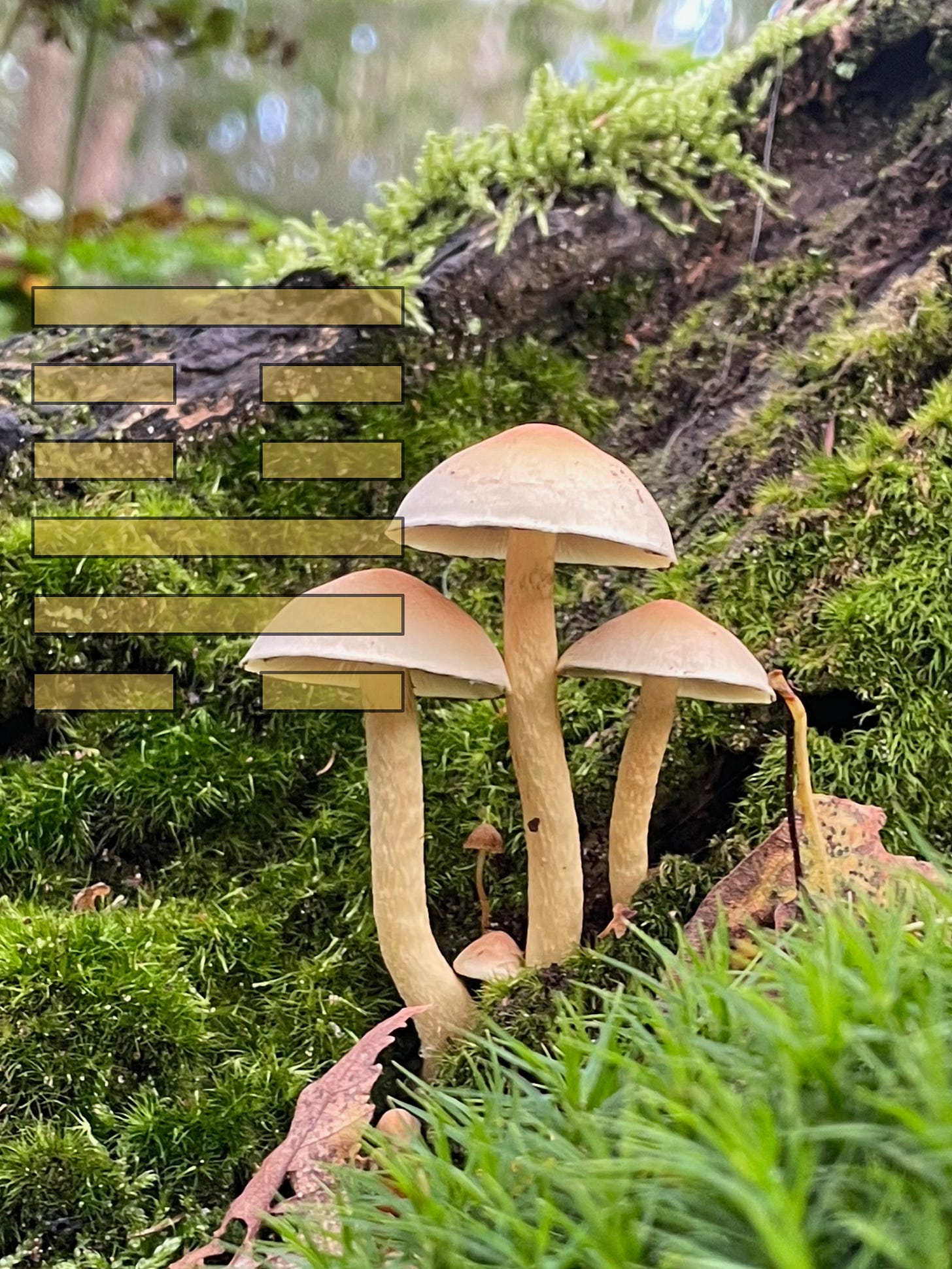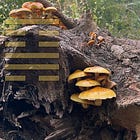Dit is the sequel to:
THE IMAGE of the two trigrams: below the Wind, above a Mountain. Inside the mountain is movement: swarming maggots and worms. A scalding waste dump, a steaming compost heap. There is decay, decomposition and conversion. A host of bacteria, yeasts and fungi are doing their work. In a wheelie bin left in the sun for a long time. In the round cheeses in the caves of Roquefort. In a barrel of wine. And last but not least: inside your own intestines. What do you see and smell when you hear the word spoilage? Poison-coloured fungi or delicate ceps? Is decay the end or a fresh start? Mushrooms are wreckers ánd innovators.
The Netherlands became a mycophobic country. Unknown makes unloved, misunderstood makes suspicious. What kind of strange boarders are they anyway? A mushroom is not a plant, as it lacks the characteristic greenery. But what's more: you need a lot of patience to watch the plant, be it a tree or grass, grow. But the mushroom: it suddenly appears, without notice. You don't pay attention for a moment and the forest floor is littered with them, as if by magic, apparitions from nowhere.
Nor is a mushroom an animal; it lacks its restless movement. How could it also run and fly with only a single limb. That contrasts sharply with the two, three, four, five, eight or a thousand legs of animals. The mushroom as a movement-restricted one-legged being, and yet appearing out of nowhere as if by magic. There must be evil magic behind that. Thought, and the suspicion arose that they might serve as seats for toads, the faithful companions of wizards and witches.


English does use the name 'toadstool', 'stool for toads', but even then: a bar stool has four legs, a small side stool has three. What comes closest is the old-fashioned one-legged wooden milk stool. Or the flip stick, an aluminium walking stick that can also be used as a one-legged seat. It would have been nice to use the walking stick to return the story to the old, support-seeking, curved backs of witches and wizards.
The English 'mushroom' seems to be derived from the French 'mousseron', 'an inhabitant of the moss'. Mousseron is the generic term for toadstools; it is also the name of some specific species. One is known to us by the name of fairy ring mushroom, which prods the magical imagination. Another is known to us as St. George's mushroom. [In Dutch language the names of many mushrooms are utmost poetic, and can not be translated easily].
Wat te denken van de vaaggegordelde gordijnzwam, de pagemantel, de meelkop, de geelbruine spleetvezelkop, de gewone glimmerinktzwam? En wist je dat deze bestonden: zwartvoetkrulzoom, het wissewasje, scheefhoofdig knikkerpluis, dubbelsnavelige witsnavelzwam, de platwrat en de kleverige zompzwam?


In my childhood, the world of mushrooms was limited to the champignon and the fly agaric. The first was on the evening menu once a week - always came in the same blue plastic container, was sterile and lacked any association with mushroom magic. This was in complete contrast to the other - for which strict warnings were issued - mere touching it would probably be fatal. So the variety was minimal and if there had ever been a mushroom culture in the Netherlands, there was nothing left of it.
Mankind can be divided into two groups when it comes to eating mushrooms: the mycophages (those who eat mushrooms) and the mycophobes (those who have a fear of mushrooms). Unsurprisingly, the mycophagus group regularly faces problems around poisoning by eating the wrong mushrooms, and this phenomenon does not or hardly occurs among the mycophobes. The English very evocatively speak of the pickers versus the kickers in this context..
Broddelboleten en Trulzwammen - Klaas Driebergen en Machiel Noordeloos
In the chapter Gastronomische Geschiedenis Johannes van Dam describes how the demise of good middle-class cuisine took place in the Netherlands from the late 19th century onwards. Whereas 17th-, 18th- and 19th-century still lifes still bear witness to the availability of a wide variety of food - albeit intended for the upper classes - there was no longer any cardamom, courgette or fresh garlic to be found in 1950s Holland. The combine of the household school, the philosophy of nutritious and cheap simplicity of the working-class menu and the emerging food industry had given short shrift to the rich culinary culture.
The many cookbooks for the middle-class family of that nineteenth century overflow with, even to us, rich dishes, from rich soups and all sorts of pasties to fanciful pies and puddings. These used all kinds of special ingredients, herbs and spices largely unknown to our own parents - or should I say grandparents - in the 1950s. Only a campaign by Albert Heijn [supermarkets] with herb racks with jars full of lifeless thyme, rosemary and other herbs ground into powder in the late 1950s introduced them for the first time to things that their own ancestors in that nineteenth century knew all too well-fresh. They had to wait years for fresh garlic in the Netherlands back then.
From Dedikkevandam - Johannes van Dam
Interest in the edible mushroom is by now back from - long - gone. But the culture around it - that can only grow back slowly.
For my work, I spent a dozen summers in the Lunigiana, a forgotten northern part of Toscana. The slopes of this 'land of the moon' are covered with vast chestnut forests. Late summer and autumn there is the time of porcini’s, of the ceps. Many of the villagers have their picking territory in the woods and head out early, returning to the village later in the day with baskets full of ceps. Sit down with us. Olive oil in the frying pan, some garlic, long slices of porcini, fry very briefly, and you are a mycophile from then on.
Anno 2010, the wild mushroom has a ferocious appeal even in mycophobic Holland. You can find a good collection of jars and bags of ready-to-eat forest mushroom soups on supermarket shelves. In an iconic episode from 2008, the Keuringsdienst van Waarde wonders in what forest those forest mushrooms do grow. And which species are involved? After straining the rather thin soup, a modest number of small pieces of mushrooms remain. Upon examination, they are champignon and oyster mushroom - both cultivated - as well as some tiny fragments of chanterelle. Although these have a wild origin, when put together they do not yet form one whole specimen. The complaint filed by the KvW focused on the misleading nature of the plural form of the product name on the packaging [in Dutch: paddenstoelen soep]. The name 'forest mushroom soup' [paddestoel soep] would cover the load better. Of course, to continue using the existing name with justification, the quantity of wild mushrooms could also be increased - to a minimum of two whole specimens per packaging.
Now, 15 years later, the soup is still on the supermarket shelf, and the magic and appeal of 'forest' and 'wild' seems undiminished. The product name mentions forest mushroom in singular [paddenstoel] - lessons have been learnt from the past. And this concerns a fresh soup, apparently prepared shortly before the expected sale.
Fresh Soup - Forest Mushroom
Ingredients: vegetables (27% champignon, 12% oyster mushroom, 6.9% onion, 4.6% shiitake, 1% spring onion), water, vegetable oil (rapeseed, sunflower), creamed butter, coconut fat, modified maize starch, salt, lentil protein, garlic, 0.2% champignon extract, yeast extract, thickener (xanthan gum [E415], methyl cellulose [E461]), sugar, spices, natural flavouring, modified potato starch, colouring agent (carotene [E160al), acidifier (sodium citrates [E331]), emulsifier (polyoxyethylene sorbitan monostearate [E435]), 0.07% cep powder, vinegar, 0.03% black summer truffle, dried vegetables (leeks, carrots), potato granules, maltodextrin, parsley extract, flavouring, truffle aroma.
The champignon, oyster mushroom and shitake are strangely named as vegetables, but so be it. All three are cultivated and they cannot be considered forest mushrooms. Ceps are, but this soup contains only 0.07% of them, namely in powder form - per pack of 500gr, that is 0.35 grams. It may also include truffle - 0.03% is 0.15 grams - less than a pinch. The addition of truffle flavouring seems to lift the forest mushroom content back up a bit, were it not for the fact that this is 2,4-dithiapentane, a petrochemical trick product. Furthermore, it is not clear what wild and fresh quality polyoxyethylene sorbitan monostearate added to this soup.
For looking for the wild or forest mushroom, the supermarket is clearly not the right location. You would expect to have to leave the city to look for them in the countryside for that, but that is not the case. An extensive survey and census at the end of the last century found as many as 1106 species of wild mushrooms in greater Amsterdam. Rob Chrispijn's fascinating guide 'Champignons in the Jordaan' reports on them.













